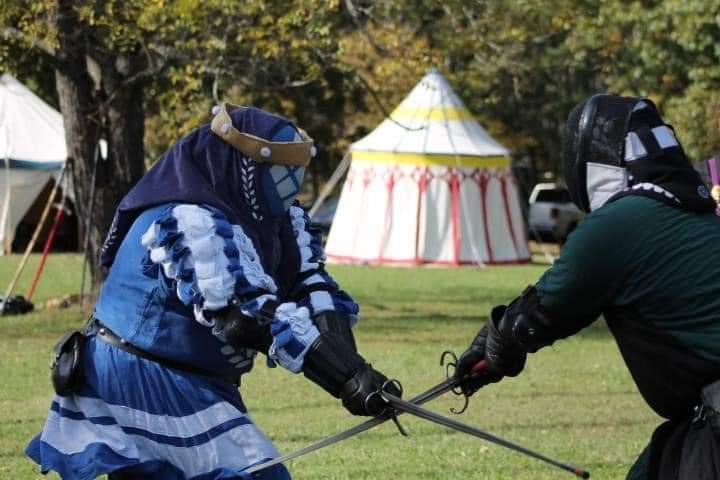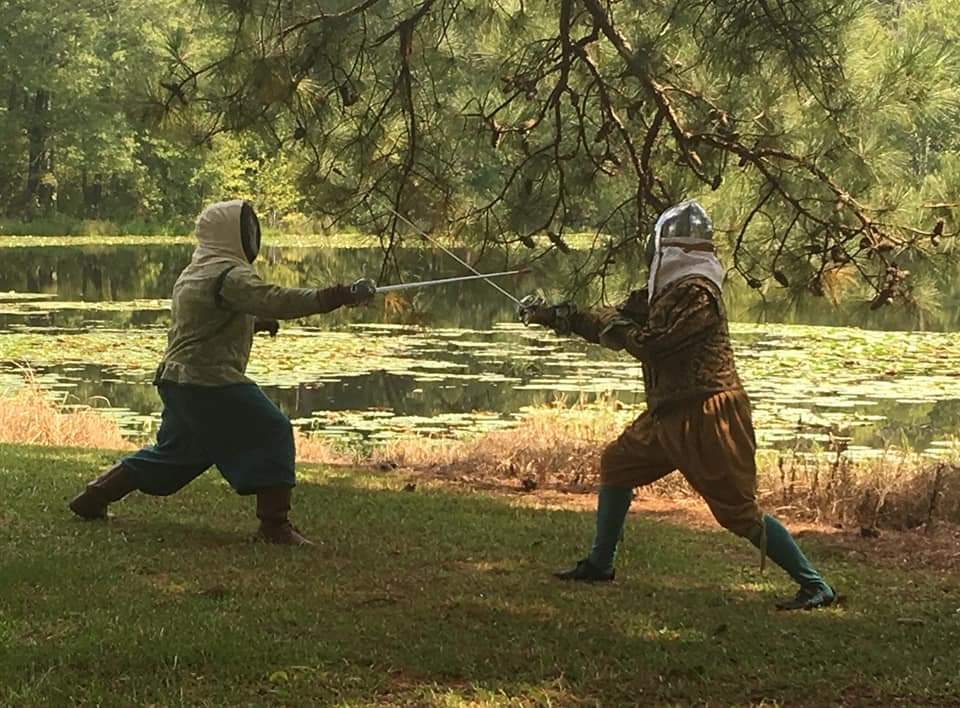WELCOME TO THE BARONY OF AXEMOOR’S RAPIER AND CUT & THRUST STEEL COMBAT PAGE
Thank you for your interest in Rapier and Steel combat in the SCA! We’re happy to have you!
On this page you will find information about participating in the SCA’s steel combat forms, from details about our discipline and helpful links, to information on safety equipment and suppliers. If you have any questions, please contact the Baronial Rapier Marshal and they will reach out to you.

RAPIER PRACTICE
We currently practice on Sundays at Shelter 1 on the New Orleasn Lakfront. you can find practice details and Google Map directions on our Calendar page.
If you are interested in learning Rapier, please contact the Baronial Rapier Marshal and they will work to get you started, and find some loaner gear.
For returning players please see these links to our calendar pages for upcoming events:
Society Registry of Kingdom Calendars
Calendar of Kingdom Event’s
Calendar for Baronial Events
WHAT IS RAPIER AND CUT & THRUST STEEL COMBAT?
Rapier and Steel combat in the SCA attempts to recreate styles of sword fighting from the very late Middle Ages through the Renaissance Era, often based on manuals and theories of combat that have survived to this day.
Rapier combat uses a foundation of style and finesse that has since evolved into the modern sport of fencing. Unlike the modern sport, our combat uses a wide variety of weapons and body protection and our combat takes place with freedom of movement in any direction. Blows in Rapier are primarily thrust oriented, with stylized cuts allowed in which the fighter places the blade on the opponent and “pulls” the cut. Our weapon simulators are blunted, unsharpened steel swords utilizing a rubber blunt at the tip for additional safety.
Rapier combat can be found in both tournaments of individual and team combatants and in larger melees and wars! In order to fight in tourneys, melees and wars you must be authorized as safe and knowledgeable of the rules by the Marshalate, and be given an authorization card, which must be kept with you at events you wish to fight in.
Our discipline also includes another form of steel combat known as Cut & Thrust. This form incorporates safe, controlled cutting blows into the fighting, which are absent in standard rapier combat. Cut & Thrust combat also allows the use of non-rapier swords and longswords, as long as they fall within our safety parameters. New combatants must already be authorized in either Rapier or Armored combat before participating in this form.
Rules for Rapier and Cut & Thrust combat can be found HERE
Society Rapier Rules can be found HERE

WHAT DO I NEED TO GET STARTED?
For newcomers, we have a small selection of loaner gear available for use including some masks, hoods, gorgets (neck protection), and fencing jackets. You will want to arrive with clothing suitable for activity in our southern climate, however long sleeves, long pants, socks, and close-toed shoes are needed. The rule here should be no skin showing other than head and hands. For those with external genitalia, you will need to bring an athletic cup to participate.
Armor in standard Rapier is designed to protect the most vulnerable points on the human body from harm. All armor has basic requirements for resistance to penetration. Before purchasing or making armor, please refer to the Society Rapier rules and consult with your Marshal.
Cut & Thrust combat requires additional protection not discussed below.
-For the head, a 3-weapon fencing mask and hood are required.
-For the neck, a suitable gorget.
-For the body, cloth armor meeting Society standards or a commercially available 3-weapon fencing jacket rated to at least 550 Newtons in all areas. Commercially produced fine weave chainmail is also available from specific makers vetted as safe for our activity. Please consult your Marshal.
-For the arms, legs, hands, and feet, cloth covering of an “abrasion” resistant material (most normal clothing is suitable).
-Personal protection: Those with external genitalia are required to wear an athletic cup, however groin protection is recommended for all. Rigid chest protectors are also available at most fencing suppliers for those that wish it.
When you get started purchasing your own equipment, the first purchases should be a 3-weapon fencing mask, good long cuffed gloves, and a gorget. From there you will want to consider body armor. 550 Newton fencing jackets suitably covered with garb or hand sewn fencing armor is fine – please consult your Marshal and the Society Rapier rules for details on what is considered to be suitable. If you are making your own armor, before doing so, consider bringing 12”x12” swatches of all the fabric layers you will be sewing so your Marshal can punch test it for penetration resistance before you put the time and effort into a finished product!

Finally, WEAPONS!!
Before purchasing your first rapier, please consider waiting and trying out rapiers already at your practice. Most fencers are happy to help with this process and your Marshal should have a rapier or two available for you to practice with. There are a wide variety of blades, guards, lengths, weights and balances and it will take time and experience to find what works for you. A Rapier is one of the most expensive parts of your fighting kit, and you may quickly outgrow an early purchase.
Rapier also uses several off-hand or “secondary” weapons and parrying devices such as daggers, cloaks, bucklers (small shields), batons (meant to simulate a walking stick or a rigid rapier sheath), and even a second rapier. Use of secondary’s requires a separate authorization apart from single-sword fighting.
Regarding equipment, there are many armor and rapier vendors – the examples below just scratch the surface, but are excellent suppliers of SCA rapier goods:
Darkwood Armory
Castille Armory
Zen Warrior Armory
There are also many manuals and books out there to get started. Some recommendations for the beginner are below:
The Duellist’s Companion by Guy Windsor
The Art of the Rapier: A Manual for Today’s Fencers by Ken Mondschein
Introduction to the Italian Rapier by Devon Boorman and Maestro Puck Curtis